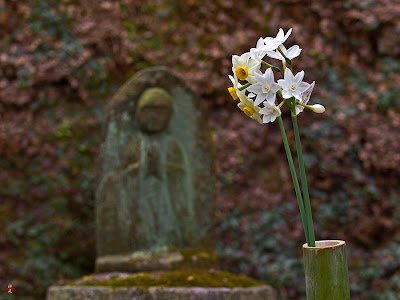My photographic notes about the four seasons in Kamakura or the gardens of Zen
January 31, 2012
Narcissus flowers in Jochi-ji
In the bitter chill of midwinter, the snow-white flowers of narcissus are nobly blooming in silence and giving off an elegant aroma to console us warmly in this cold gloomy season.
In Japan, this plant is called Sui-sen, which means "a water hermit" because it grows at the edge of water and bears pure white flowers.
Like fairies standing still at the waterside, the flowers of Sui-sen are blooming innocently as if to be free from the any hardship of this nearly colorless season.
A snowy heron in Engaku-ji
A snowy heron was perching quietly on an empty water-lily basin in front of the gate to the Shari-den (the hall of Buddha's bones).
A deep stillness reigned over the garden of winter.
The frozen garden of Engaku-ji
The frozen ripples of the pond dimly reflected the pale sunlight of winter.
In the crisp calmness of the garden, the passage of time was eternally frozen before my eyes.
The buds of Mitsumata in Tokei-ji
Soon the flowers of Mitsumata (Edgeworthia chrysantha) will bloom splendidly as one of the first heralds of spring in Kita-kamakura.
In the intense cold of winter, its downy flower buds, which look like the small paws of silver kittens, are growing steadily for their blossoming.
Daffodil flowers in Tokei-ji
White Suisen flowers were offered to the doll-like stone statue of Jizo-bosatsu (the Guardian Deity of Travelers and Children).
Dead flowers of Ajisai in Tokei-ji
The dead flowers and dried branches of Ajisai created an exquisite piece of artwork in the cold winter garden.
The buds of Ume in Tokei-ji
The countless flower buds of Ume (Japanese apricot) are appearing one after another under the cold wintry sky.
Soon we will see the elegant sign of early spring.
January 17, 2012
The sunset at Yuigahama-beach
Through the chilly and dry air of January, the sunset casted blazing glow over the sea.
The bright colors of nature have mostly faded away in this gloomy season. Precisely for this reason, we can again wake to the true value and preciousness of the beauty which this world gives us.
Winter-peony flowers in Tsurugaoka-hachimangu
Peonies ordinarily flower in April and May. The winter flowering of peonies is artificially activated by using the traditional skill of late raising to present the auspicious and elegant flowers which will bring good fortune in a new year.
In spring and summer, the natural flowering of this plant is inhibited by placing it in a cold environment. In autumn, it is nursed carefully in a temperature-controlled condition to prepare for winter.
After this painstaking process of nursing is continued for two years, the flowers of winter peonies bloom magnificently in harsh and gray winter.
The splendid winter flowers of peonies seem to warm up the spirits of those around them like a cheerful fire in this cold and flowerless season.
Subscribe to:
Posts (Atom)












